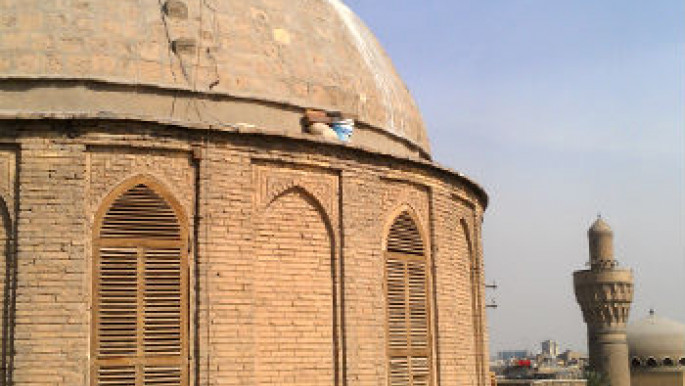The hidden past of Baghdad's 'forgotten' Latin Cathedral
"The church doors are open to all visitors, Christian and Muslim," reads the banner draped across the gate of the Saint Joseph Cathedral, in Baghdad's al-Khulafaa Street.
The Latin Cathedral, also known to people as the Church of the Virgin Lady, was built in 1866 to replace a smaller structure on the same site. Opened in 1871, the church was built in the shape of cross, and its iconic dome stands some 10 metres high.
Anastas Mary the Carmelite, the prominent late Iraqi priest, scholar and linguist, lies in the courtyard of the church.
The building was used as a hospital during the First World War, and it was partly burned by the Ottomans in 1917. In the early 1970s, when Egyptian immigrants came to Iraq for work, the church was put at the disposal of the arriving Orthodox Copts.
In the 1990s, a commercial complex was built on a portion of its courtyard and a statue of Saddam Hussein was erected at the front. It marred a centuries-old view of the church.
A young priest, who spoke on the condition of anonymity, told The New Arab that the head of the Latin Church was obliged to accept a land reclamation contract for the building of the complex.
"No one dared to say no to the regime," he said.
Taking advantage of the chaotic state following the US-led invasion in 2003, shop owners expanded their stores and trespassed on territory belonging to the church. There were no laws to protect the place of worship from such encroachment.
 |
They even stole the bell rope. What value does it have? |  |
Stealing from the church
As violence swept across the country, police officers were assigned to protect the church from potential attacks by militant groups. Instead, the police allowed kiosk owners from the surrounding Shorjah market to throw the cathedral's furniture outside, and to store their merchandise in the church hall.
|
With the protection offered by police nothing more than nominal, ancient statues were ruined and other church belongings were stolen.
"They even stole the bell rope. What value does it have?"
The priest complained that in recent years, local shopkeepers had been inciting ill feelings between the two prominent communities here.
"You often hear things like, 'don't visit, the priest won't allow Muslims in'," he added.
But despite the hatred stirred by some, in an old tradition, Muslims still often visit churches to light candles and seek the blessings of the Virgin Mary.
Today, the church is in a saddening condition. Damp walls, broken windows and barely useable furniture - a sorry state reflective of the epic failure of post-invasion governments.
Huthaifa al-Nuiamim, a Muslim Baghdad resident who frequently visits to light a candle and pray, expressed his anger over the situation.
"This wouldn't happen if it was a Masjid or Husseiniya. This is very sad to witness," he said, referring to Sunni and Shia mosques respectively.
While corrupt Shia and Sunni political parties have all the money and power in their hands, Christian Iraqis, among others from different ethnicities, feel abandoned.
 |
In the absence of maintenance or any preservation plans, Baghdadis fear the imminent loss of another renowned landmark of their city |  |
Minarets and bell towers
In the absence of seasonal maintenance and continuous assessment of the state of this historical church, a single bout of heavy rain was enough to destroy a portion of its dome, which, in a scene out of 1001 Nights, faces the minaret of the 1000-year-old Abbasid-era al-Khulafaa mosque.
 |
|
| St Joseph's Cathedral has been neglected [Nabil Salih] |
"Prior to 2003, experts always looked after the church. Things were way better" the priest added.
In response to recurrent calls from activists and the Christian community in Baghdad to save the cathedral, "Haider al-Abadi stepped in, sending a special force and the makeshift storehouses shop owners built were removed", the priest said.
"Police officers who were assigned to protect us and turned a blind eye to multiple intrusions and harassments were arrested as well."
However, the deterioration of the ramshackle cathedral is accelerating. In the absence of systemised maintenance or any preservation plans, Baghdadis fear the imminent loss of another renowned landmark of their city.
Violence escalated immediately after invading armies led by the United States, marched to "liberate" Iraq from Saddam. Instead they "opened the gates of hell", said one priest.
Since 2004, at least 118 churches have been attacked, with Christians threatened and displaced from their homes by Sunni and Shia militias. In October 2010, gunmen attacked Baghdad's Sayedat al-Najat ["Our Lady of Salvation"] church during a mass, killing 58 worshippers.
When IS militants invaded Mosul in 2014, the city was entirely emptied of its Christian population.
Of the estimated 1.5 million Christians living in Iraq before the 2003 invasion, only around 200,000 remain, mostly living in the northern provinces of the country.
Fourteen years on, politicians don't seem to have a plan regarding the precarious situation in the country - let alone its places of worship.
Nabil Salih is a Baghdad-based engineer and writer.





 Follow the Middle East's top stories in English at The New Arab on Google News
Follow the Middle East's top stories in English at The New Arab on Google News


